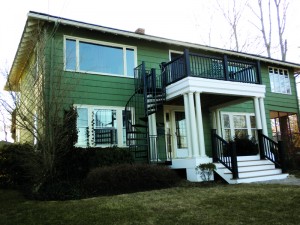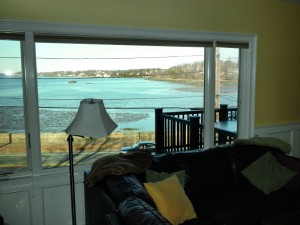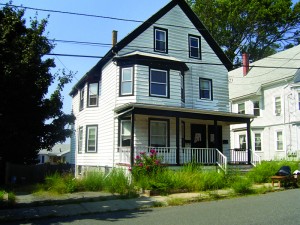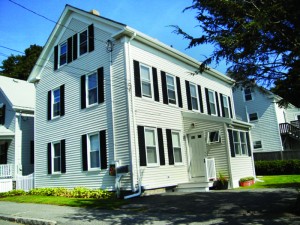In the downtrodden world of residential real estate, the multi-family property is enjoying some time in the spotlight. By, Regina Cole
There’s a bright spot in the dark world of post-bubble real estate sales: North Shore realtors report that while single-family homes continue to languish, unsold multi-family houses are flying off the shelves.
“Multi-families were hotly desirable in 2004, then went way down,” says Christina Rafter of Re/Max Advantage in Gloucester. Rafter grew up here and has spent decades selling real estate in her hometown. The widow of Bill Rafter, one of Gloucester’s best-loved mayors, she spots emerging real estate trends on Cape Ann sooner than most. “For years, they were even harder to move than single-family homes,” says Rafter. “Now multi-families are selling again, at a rapid rate.”
Rafter echoes her fellow North Shore real estate professionals, who report the same trend in Salem, Newburyport, Beverly, and Lawrence. All see the uptick in the two- to four-family multi-family houses common to the North Shore. Buildings with large numbers of apartments, many of them owned and managed by large national and multi-national companies, are relatively rare in this area. The rich stock of small multi-family dwellings was largely created during New England’s deep history, which includes a sustained housing boom lasting from the mid-19th century until World War I. During those years, North Shore residents built vast numbers of homes, including multi-families, many of which survive today.
The picturesque Victorian houses of the late 19th and early 20th century, lavishly built for newly well-off families and their servants, maintain much of their elaborate appeal. Most were converted to apartments many years ago and were then renovated and converted to condominiums. Whether for sale or for rent, these units are considered desirable, with the best boasting superb construction, generously proportioned rooms, and beautiful architectural elements. Apartments in sensitively converted Victorians retain their original stained glass, grand staircases, paneling and wainscoting, parquet floors, crown molding, fireplaces, and built-ins.
In addition to these Victorian beauties, the North Shore is rich with multi-family houses from the 18th to the 20th centuries. The area also boasts splendid examples of New England’s unique contribution to American vernacular architecture: the three- and four-decker. They date from as long ago as 1875; most were built during the early to mid-20th century. Ubiquitous in New England’s old industrial centers, this blocky urban architectural form-think Salem, Lynn, Lawrence, and the old centers of Danvers and Peabody-features family-friendly layouts, porches, and sturdy construction. Rooms are often large, with high ceilings and natural ventilation. While realtors agree that owning high-quality multi-family real estate never totally lost its appeal, area professionals describe a perfect storm of social and financial events that have come together to create this demand now.
“Price plays the leading role,” says Phil O’Donnell of Armstrong Field Inc. Real Estate in Salem. “While residential prices have dropped by 10 to 15 percent, multi families are now listing for 20 to 30 percent less than a few years ago,” he explains. “For example, in 2005, a good two-family house in Salem and Beverly listed for $350,000 to $385,000. Now, the same house lists for $275,000 to $300,000.”
Richard Brenner of the eponymous Andover firm ticks off more numbers.”In Lawrence, 76 multi-family houses were sold in the last 10 months.” He explains why multi-families are such an attractive investment. “In Lawrence, a three-decker that used to sell for $350,000 now lists for as low as $157,000,” he says. “One recently  sold for $200,000 within five days. The annual income from that three-family was listed at $38,000.”
sold for $200,000 within five days. The annual income from that three-family was listed at $38,000.”
Brenner, who has worked as a real estate broker since 1992, says, “The uptick is all due to foreclosures. This is a cuckoo market.” He describes as predators those “real estate companies that advertise on TV, taking advantage of people by convincing them that their problems will be solved with a short saleÂ…They don’t solve anyone’s problems, and all the short sales drive down prices.” For Brenner, it’s a question of ethics. “I will not get involved in a short sale,” he says firmly.
Lynne Saporito also reports heightened activity in the Beverly area. Half of the team of Lynne Saporito and Sandy Carpentier of J. Barrett Realty in Beverly Farms, Saporito sees far more multi-families selling much more quickly than usual in what is usually a stable area.
“I can tell you that in the town of Beverly in the past six months, there have been a total of 35 multi-family listings,”  she says, adding that “16 are unsold and currently on the market, seven are under contract, and 12 are sold. So I would agree that this category has picked up.” She does the math: “Seven under contract and 12 sold equals 19 that have buyers-that’s 54 percent.”
she says, adding that “16 are unsold and currently on the market, seven are under contract, and 12 are sold. So I would agree that this category has picked up.” She does the math: “Seven under contract and 12 sold equals 19 that have buyers-that’s 54 percent.”
Saporito believes that low prices, together with exceptionally low interest rates, make multi-families especially attractive to investors. “The increase in multi sales is very likely due to investors taking their cash out of the volatile stock markets and putting it into real estate while prices are low and mortgage rates are good,” Saporito says. “At the same time, the demand for rental units is very high right now because of all the short sales and foreclosures. Those people cannot buy and need to rent. This [demand] is driving up rental prices.”
Christina Rafter adds, “For quite a few years, kids lived with their parents because they couldn’t find jobs and thus could not afford to live independently. I see a lot of those young people now moving into apartments of their own.”
Because of the low prices and increased demand, the five-day sale Brenner quoted is not unusual. But in affluent communities, quick sales are generated by limited supply, as well as attractive sale prices. “Our inventory is very low right now,” Phil O’Donnell says. “Partly that’s due to increased demand. But another factor in this area is that, in early 2000, lots of developers condo-ized multi-families, so now those units are not available anymore.”
O’Donnell, who sells real estate all over the North Shore, points to high-end conversions of large Victorians on Marblehead Neck and stately Federal manses in downtown Salem as examples. “Big estates in Manchester-by-the-Sea and Pride’s Crossing finally passed out of family hands. They now house discreet, elegant condominium apartments,” he says.
O’Donnell refers to a chart generated by the North Shore Association of Realtors. While prices for single-family homes dropped slightly between 2010 and 2011–and dropped steeply for condominiums and co-ops-multi-family prices actually rose during the same period. “Price is up 12.1 percent but unit sales are down 16.3,” he says. “This could be due to lack of inventory.”
 Inventory, or lack thereof, also bedevils Pam Hill Shuster of Newburyport’s Coldwell Banker. “There are 10 multi-families listed in Newburyport, and one is under agreement,” she says. “All are two- to four-family buildings. Sadly,” she adds, “none of [the listings] are mine.” In the Port City, she says, it’s 2000 all over again.
Inventory, or lack thereof, also bedevils Pam Hill Shuster of Newburyport’s Coldwell Banker. “There are 10 multi-families listed in Newburyport, and one is under agreement,” she says. “All are two- to four-family buildings. Sadly,” she adds, “none of [the listings] are mine.” In the Port City, she says, it’s 2000 all over again.
“Builders are buying them, rehabbing, and then converting them to condominiums,” says Shuster. “Newburyport is walkable, which is very appealing to downsizing empty nesters. They love the fact that they can stroll to restaurants, movies, or the theater.” The preponderance of the city center’s early 19th-century brick buildings, however makes for some quixotic units. “Some of those staircases are very steep!” she says.
But, until interest rates and real estate values climb, buyers believe that climbing steep stairs is a small price to pay for an exceptional real estate value. With our preponderance of beautiful historic buildings, this is true all over the North Shore.

